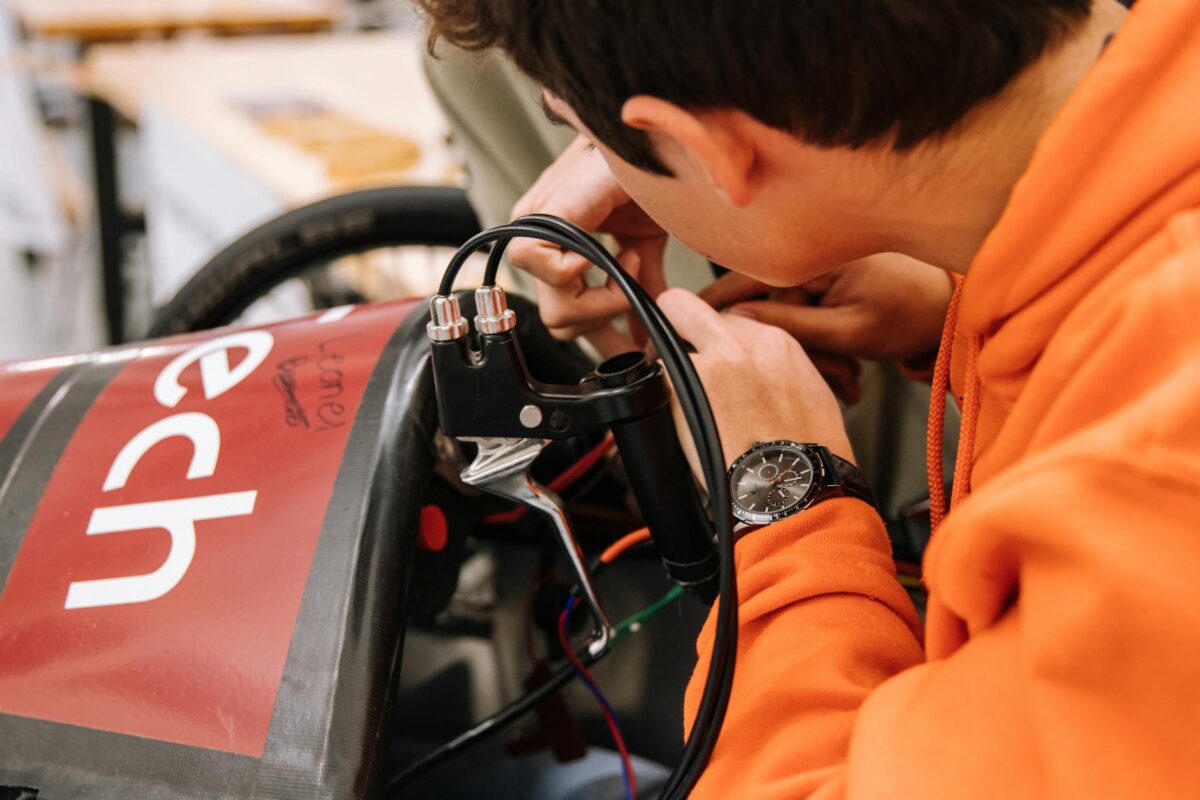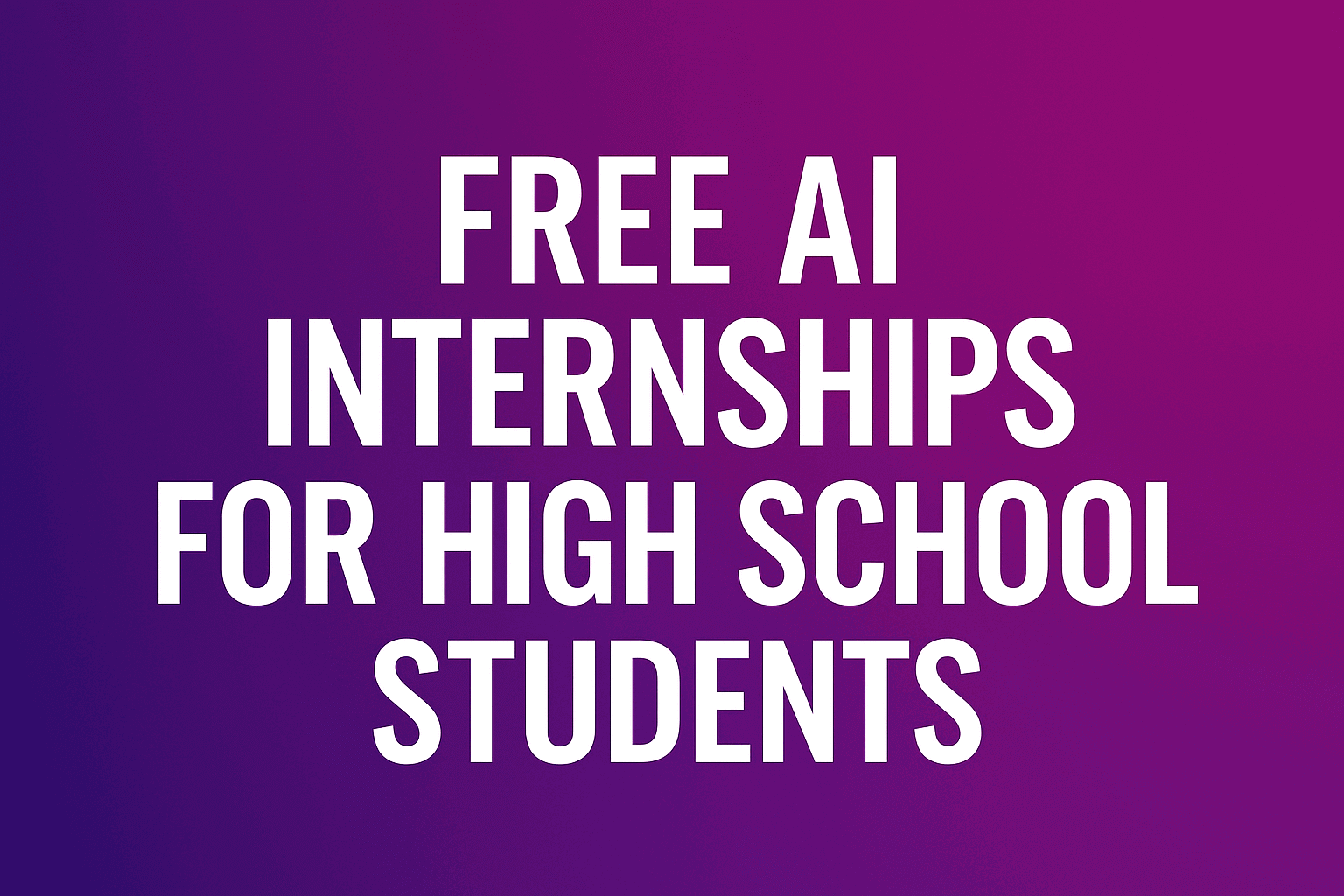Dreaming of real-world AI work before college? A free AI internship can open a door, even if you’re just starting to code. In this guide, you’ll learn how to find an Artificial Intelligence Internship that costs nothing and actually builds skills.
Here’s what “free” means for teens: no tuition, possible stipend for your time, and covered materials like cloud credits or a laptop loan. Some programs also include mentors, workshops, and a final project you can show on college applications.
Spots are limited, so apply early and apply broadly. You’ll need a tidy resume, a short portfolio or GitHub, and a clear story about why you care about AI.
What’s inside:
- Top free programs worth your shortlist
- How to qualify, step by step
- What the day-to-day work looks like
- Strong alternatives if ai interships are full

What Counts as a Free AI Internship for Teens?
A free AI opportunity should give you real project experience, access to mentors, and zero tuition. Many teens build strong portfolios through three paths that all count as experience: internships, bootcamps, and research mentorships. The label matters less than the quality of guidance and the work you ship. If it teaches skills, includes feedback, and ends with a demo or report, it fits the spirit of a free Artificial Intelligence Internship and belongs on your resume.
The Main Paths: Internship, Bootcamp, or Research Mentorship
You can reach the same goal through different doors. Use the path that fits your schedule, skills, and access.
- Internship at a lab or company
- Pros:
- Real-world tasks with clear deliverables.
- Mentors review your code and pull requests.
- Strong resume signal and references.
- Cons:
- Competitive applications and limited seats.
- Work hours can be fixed, even for remote roles.
- Projects may be narrow, tied to team needs.
- Pros:
- Bootcamp with mentor-led projects
- Pros:
- Short, structured sprints that build core skills fast.
- Many include guided, portfolio-ready projects.
- Often beginner friendly and free if sponsored.
- Cons:
- Quality varies by host and mentors.
- Pace can be intense for new coders.
- Some “free” options cap advanced content.
- Note: Some programs say “bootcamp,” but still provide mentors, code reviews, and team projects. If you ship a model, notebook, or app, it counts as experience similar to ai interships.
- Pros:
- Research mentorship with a professor or grad student
- Pros:
- Deeper focus on a question, dataset, or method.
- Training in reading papers and writing reports.
- Strong letters and a chance to submit to fairs.
- Cons:
- Unstructured time requires self-management.
- Results may be uncertain or slow.
- Finding a willing mentor takes outreach and patience.
- Pros:
Eligibility and Skills You Need (Even as a Beginner)
Most free programs want motivated teens who can show up, learn fast, and finish a project. You do not need perfect grades to start.
- Age and grade: typically 14 to 18, rising sophomores to seniors.
- Reliable internet: stable connection for remote meetings and uploads.
- Beginner Python: variables, lists, loops, functions, and reading errors.
- Tools comfort: Google Colab or Jupyter for notebooks and GPU runtime.
Strong habits beat raw talent. Curiosity and consistency matter more than perfect grades. A small, clean project in a public repo often speaks louder than test scores.
Red Flags and How to Avoid Fake “Free” Offers
Free should mean free. Protect your time and data with a quick filter before you apply.
- Upfront fees or “processing” charges.
- Vague project scope with no examples or past work.
- No named mentors or missing LinkedIn profiles.
- Pressure to accept within 24 hours.
Due diligence checklist:
- Check mentors and partners: find names, credentials, and recent activity.
- Review past student projects: look for GitHub links, demos, or write-ups.
- Confirm costs in writing: tuition, tools, and cloud credits.
- Read policies: data use, IP ownership, and publication rights.
- Ask for a sample syllabus: topics, tools, and assessment style.
If a program is truly free, it will say so clearly, list mentors, and show examples of completed work. Trust clarity, not hype. When in doubt, pick the path where you can build, learn, and publish your results. That is what turns ai interships and related experiences into real outcomes you can point to.
Best Free AI Internships and Bootcamps for High School Students in 2025
Curious about real projects, mentors, and a path into AI without paying tuition? These free and scholarship-backed options help you build skills and ship a demo. If you are chasing ai interships or any serious Artificial Intelligence Internship, the programs below are reliable, organized, and beginner friendly.
You will see a mix of short bootcamps, structured online courses, and research internships. All end with a tangible outcome, like a model, a report, or a demo app you can add to your portfolio.
Mark Cuban Foundation Free AI Bootcamp
The Mark Cuban Foundation runs a free, 20-hour AI bootcamp for high school students each November. It meets on three Saturdays and pairs you with mentors for hands-on work. See dates, eligibility, and locations on the official site under the student section: Mark Cuban Foundation AI Bootcamp for Students.
- Format
- Free, 20 hours, three Saturdays in November.
- Local host cities partner with the foundation and volunteer mentors.
- Focus
- AI basics and core ideas explained in plain language.
- Ethics and responsible use of data and models.
- Hands-on projects in small groups, guided by mentors.
- Career exposure through panels and mentor talks.
- Audience
- Welcomes beginners, including students with limited coding.
- Strong outreach to underrepresented students in tech.
- Action steps
- Find a host city on the program site; new cities appear through late summer.
- Apply in early fall, then confirm your schedule for November sessions.
- Bring a laptop if you have one, or ask the host about loaners and Wi-Fi.
- Outcome
- A demo project you can present or share, such as a simple classifier or app concept.
- Clear next steps to keep learning, plus insight into AI careers.
Tip: Prepare a one-page resume and a short note on why AI matters to you. Simple and honest beats buzzwords.
MIT Beaver Works Summer Institute (CogWorks)
MIT’s Beaver Works Summer Institute offers CogWorks, a virtual AI track that blends an online course with project-based learning. You will practice Python and machine learning, then build with voice or vision tools. Explore program details and updates on the official page: MIT BWSI CogWorks.
- Format
- Online pre-course in Python and ML, followed by team projects.
- Structured milestones, mentor feedback, and a final presentation.
- Timing
- Apply early in 2025; the main session runs July to August.
- Expect a paced schedule with weekly deadlines.
- Cost
- Free for accepted high school sophomores and juniors.
- Skills gained
- Python coding, data prep, and ML basics like classification and evaluation.
- Building with voice or computer vision tools, depending on projects.
- Version control and collaboration habits that recruiters value.
- Tip
- Complete the online pre-course before you apply. It strengthens your application and helps you ramp faster.
Pro move: Keep a public GitHub repo for your pre-course work. Reviewers like proof of follow-through.
Stanford AIMI High School Research Internship
Stanford AIMI’s two-week virtual research internship focuses on AI in medicine and imaging. You will work with real datasets, hear from clinicians and researchers, and learn the basics of training models. Check current eligibility and dates on the official program page: Stanford AIMI Summer Research Internship.
- Focus
- Medical imaging datasets, labeling, and data quality.
- Intro model training, validation, and error analysis.
- Talks from researchers on clinical impact and ethics.
- Cost
- The program may have fees; scholarships can be available.
- Review the site for current financial aid details.
- What to expect
- Small-group research tasks, a short report, and a final share-out.
- Light coding in Python or notebooks, aimed at beginners with support.
- Tip
- Highlight any biology, health, or imaging interest in your application. A clear tie to healthcare helps.
Outcome: You finish with a research-style summary and better context for how AI supports real clinical work.
Veritas AI Internship Program Scholarships
Veritas AI runs remote mentorship and project-based learning for high school students who already have some AI interest. The standard program is paid, but you can ask about need-based aid or scholarships.
- Format
- One-on-one or small group mentorship.
- Project sprints with defined milestones and feedback.
- Cost
- Paid by default; inquire about scholarships and need-based aid.
- Outcome
- A guided project you can publish as a portfolio piece.
- Tip
- Bring a clear project idea to stand out. Examples: a small sentiment classifier for local news, or a vision tool that counts traffic for your school.
If you apply without a robust background, share a short prework sample. Even a basic notebook shows initiative.
Where to Find More Free Listings and Scholarships
Several platforms collect AI and CS opportunities. Many include free options, sliding-scale pricing, or financial aid. Start a simple tracker for deadlines and requirements.
- Inspirit AI, StandOut Connect, Polygence
- Browse listings and filter for scholarships or fee waivers.
- Confirm high school eligibility and time zones before you apply.
- Look for early deadlines, especially for summer programs.
- Quick search tips
- Use terms like “high school AI scholarship,” “tuition-free AI bootcamp,” and “financial aid available.”
- Scan past student projects to gauge quality and fit.
Keep a short email template to request aid. Ask early, be specific about your need, and attach a resume or portfolio link.
Build a Strong Application in 30 Days
You can build a standout application for ai interships and any Artificial Intelligence Internship in a single month with a tight plan. Focus on small, shippable projects, clean documentation, and social proof. Think like a builder, not a browser. Finish work, record it, and publish it so decision-makers can skim and say yes.

A clear 30-day sprint looks like this: pick 2 simple projects, document daily, post weekly updates, and send two cold emails with your work. For inspiration and a student-first mindset, see Explore LearnAiMind’s approach to student-friendly AI education.
Quick Portfolio Projects You Can Finish Fast
Your goal is two small wins, not one huge hero project. Keep each build to one week, then spend a day polishing the README and a short demo video.
- Train an image classifier in Google Colab
- Use a small dataset, such as 200 to 500 images, and a pre-trained model.
- Show metrics like accuracy and a confusion matrix.
- Deliverables:
notebook.ipynb,README.md, 60-second demo video, GitHub link.
- Fine-tune a small language model for FAQ help
- Create a CSV of Q&A pairs from your school club, library, or local nonprofit.
- Fine-tune or prompt-tune a compact model and test on held-out questions.
- Deliverables: dataset file, notebook, sample outputs, demo video, GitHub link.
- Build a simple sentiment analyzer
- Classify student feedback or club comments as positive, neutral, or negative.
- Show a few error cases and how you would improve them.
- Deliverables: notebook, quick write-up on evaluation, charts, GitHub link.
- Make a data dashboard for school recycling data
- Pull weekly bin weight or pickup counts from your school or city site.
- Use a lightweight framework like Streamlit and add a simple trendline.
- Deliverables: hosted app link, screenshots,
README.mdwith how-to run.
- Create a quiz bot for any subject
- Feed it trusted notes, set rules for hints, and cap the answer length.
- Add a short log of user tests and common failure modes.
- Deliverables: short demo, usage guide, GitHub link, known issues section.
Best practice polish:
- Keep a clear README with problem, approach, results, and next steps.
- Add a short demo video, 45 to 90 seconds, recorded with screen capture.
- Post a public GitHub link with a descriptive repo name and tags.
Tip: Each project should answer three questions fast, what it does, how it works, and what you learned.
Resume and LinkedIn for Teens
Keep your resume to one page. Use action verbs, numbers where possible, and direct links to your work.
One-page resume structure:
- Contact: name, city and state, email, GitHub, LinkedIn.
- Education: high school, grad year, GPA if strong, relevant courses.
- Skills: Python, Google Colab, pandas, NumPy, Git, Streamlit, scikit-learn.
- Projects: title, 1-line summary, 1 to 2 bullets with results, link to repo or demo.
- Awards: math contest, science fair, hackathon mention, school honors.
- Activities: clubs, volunteer roles, tutoring, part-time work.
Example project entry:
- Sentiment Analyzer for School Feedback, 85 percent F1 on test set; built in Colab. Improved recall on neutral class after error review. GitHub link.
LinkedIn tips that work:
- Headline: “High School Student, AI Projects” plus 1 to 2 skills, like “Python, Colab.”
- Photo: clean, well lit, simple background, centered face.
- About: a 3 to 5 sentence summary of your interests and recent projects.
- Posting: short build logs once per week, 3 to 5 sentences with a screenshot.
- Projects: add GitHub links under “Projects,” and tag skills so recruiters see them.
Pro move: Pin your best project and your demo video at the top of your profile.
Cold Email Templates That Get Replies
A good cold email is short, clear, and respectful of time. Keep it to five sentences with one specific ask.
Subject: High school student with two AI projects, request 3-hour feedback sprint
Email body:
- I am a high school junior in [City] who is building small AI projects.
- I trained a simple image classifier and a FAQ helper; both are on GitHub with short demos.
- I want to learn better evaluation and how to scope a real task.
- Would you be open to a 3-hour feedback sprint next month, or a small review task I can complete and return?
- Portfolio and links: [your-portfolio-link] and GitHub.
Follow-up schedule:
- Day 4: Reply to the same thread with a polite bump and one new update.
- Day 10: Share a quick progress note and one-line question.
- Day 21: Final follow-up, thank them, and note you will circle back with new work.
- After a reply: Confirm time, send calendar invite, and share a one-page brief.
Keep a simple tracker of who you emailed, the date, and the response.
Recommendations, Transcripts, and Deadlines
A clean process avoids last-minute stress. Use this checklist and stay three to four weeks ahead.
Application checklist:
- Ask recommenders 3 to 4 weeks early. Share your resume and top project links.
- Give each recommender a short brag sheet with your goals and key projects.
- Confirm transcript steps with your counseling office, including processing time.
- Track all deadlines in a simple spreadsheet with columns for program, due date, materials, and status.
- Proofread essays for clarity, voice, and alignment with program values.
- Match each essay to the program. If it stresses ethics or community work, include an example from your projects.
- Name files clearly, like LastName_FirstName_Resume.pdf and ProjectName_Demo.mp4.
Smart quality checks before you submit:
- Read out loud once. Fix any long, confusing sentences.
- Click every link and test on mobile.
- Check your GitHub README from a fresh browser so you see it as reviewers do.
A strong 30-day sprint can move you from applicant number 412 to a clear yes. Finish two small projects, document well, and send focused outreach. That is how you stand out for ai interships and any serious Artificial Intelligence Internship.
What Work Looks Like in an Artificial Intelligence Internship
An Artificial Intelligence Internship for high school students feels like a mini research lab mixed with a starter software job. You will clean data, test simple models, write short notes, and share your progress. Most ai interships focus on small, real tasks you can finish in days, not months. The goal is to learn, ship, and show your work.

Daily Tasks and Tools You Will Use
You will spend most days moving a project forward in small steps. Expect hands-on work with data, code, and simple reports.
Common tasks:
- Data cleaning, like fixing missing values and trimming outliers.
- Data labeling, using a guideline to tag images or text.
- Setting up notebooks, organizing files, and documenting runs.
- Model training on small datasets you can run in Colab.
Core tools:
- Python for scripts and notebooks.
- Google Colab or Jupyter for interactive work.
- pandas and scikit-learn for data prep and baseline models.
Use this quick map to match tasks to tools:
| Task | Primary Tool | Why it helps |
|---|---|---|
| Clean and join data | pandas | Fast, readable data transformation |
| Baseline models | scikit-learn | Quick tests, clear metrics |
| Small deep models | TensorFlow/PyTorch | Pretrained layers, simple fine-tuning |
| Interactive experiments | Colab/Jupyter | Run cells, track outputs, easy sharing |
| Team collaboration | GitHub | Version control, reviews, documentation |
Pro tips:
- Keep notebooks short. Use one notebook per experiment.
- Name files clearly, like
01_baseline_logreg.ipynb. - Save charts for your report. Screenshots of confusion matrices help a lot.
Ethics, Privacy, and Safe Use of AI
Strong internships teach you to protect people, not just improve metrics. You will talk about bias, consent, and safe outputs, and you will write what your model should not do.
Key ideas to practice:
- Bias and fairness: check if results vary by group. Use clear metrics and sample sizes. A short note on disparities belongs in every report.
- Consent and sources: label only with data you are allowed to use. If in doubt, ask the mentor and document the data license.
- Sensitive data: medical or school data needs stricter handling. Follow rules on storage, access, and deletion. Never move data to a personal device.
- Safe prompts and outputs: set boundaries. Do not generate health, legal, or financial advice. Add warnings and guardrails where needed.
For a quick primer on these themes, review this plain-language guide on AI ethics basics and why they matter. If you want classroom-ready practices, the Harvard Graduate School of Education has tips for developing AI ethics in the classroom.
Example README section to document model limits:
- Intended use: classify school club posts by topic for planning.
- Not for: safety decisions, attendance, discipline, or grading.
- Data: 1,200 labeled posts from public club channels, 2023 to 2024.
- Known limits: struggles with slang and mixed-language posts.
- Fairness check: tested on three clubs; lower recall on smaller clubs.
- Safety rules: no personal data, no names stored in logs.
- Next steps: collect more samples from underrepresented clubs.
Clear limits show maturity. Reviewers trust interns who say what a model can and cannot do.
A Simple Weekly Schedule for a Remote Internship
A steady routine keeps you moving from idea to demo. Here is a starter schedule that fits most remote ai interships.
- Monday, 2 hours: Kickoff and plan
- Standup, goal for the week, and success metric.
- Set up dataset folder, repo, and first issues.
- 30 minutes of study on a method you will use.
- Tuesday, 2.5 hours: Data review and prep
- Explore data, clean fields, and label a small batch.
- Save charts that show class balance and missing values.
- 20 minutes of reflection, capture questions and blockers.
- Wednesday, 3 hours: Build day
- Train a baseline model, log metrics, and save artifacts.
- Try one improvement, like better features or a different split.
- 30 minutes of study tied to your next change.
- Thursday, 1.5 hours: Mentor check-in
- Share a short update, metrics, and error examples.
- Agree on one or two clear next steps, not five.
- 15 minutes of reflection, update your README.
- Friday, 2 hours: Test and present
- Finalize a small demo, a chart, and a one-page summary.
- Record a 60 to 90 second screen-share video.
- Plan Monday’s target and open issues in GitHub.
Keep your notes tight. A one-paragraph log each day beats a long weekly write-up.
How to Get Mentorship and Feedback
Mentors respond well to clear, respectful requests. Make it easy to review your work and suggest a next step.
Tips that work:
- Ask focused questions: “I tested three tokenizers. Which metric matters most here, F1 or recall, and why?”
- Share a short Loom demo: 60 to 90 seconds showing the problem, the run, and the result.
- Keep a running blockers log: one list in your repo with dates and current status.
- Request code reviews: open small pull requests with a short summary and two specific asks.
- Set a weekly goal: one outcome you can measure, such as “reach 75 percent F1 on validation.”
Simple feedback flow:
- DM or email the Loom link and the PR.
- Ask two questions max.
- Propose your next step to show you thought it through.
How to accept feedback with gratitude:
- Thank the mentor by name.
- Restate the advice in one line to confirm.
- Apply it fast and report back with results.
If you want a broader view of typical projects and expectations, skim an overview like what to expect in a high school AI internship. It can help you frame better questions during your next check-in.
Key takeaway: ship small updates often, document your reasoning, and invite review. That is how you grow fast in any Artificial Intelligence Internship.
No Offer Yet? Free Ways to Gain AI Experience That Still Count
You do not need a formal offer to build real experience. Plenty of free routes mirror the day-to-day work of ai interships and help you stand out for any Artificial Intelligence Internship. Think in weeks, not months. Set small goals, publish often, and track proof of impact.

Join Virtual Research or Citizen Science
Jump into public research like you already have a lab badge. It is a simple way to practice core skills recruiters expect.
- Labeling and data quality: Many projects need help tagging images or text. Follow a short guide, label a batch, and document edge cases you notice.
- Open datasets: Start with a defined question, such as “Can we predict bus delays from weather?” Pick a public dataset and write a testable plan.
- Read lab preprints: Skim the abstract, intro, and figures. Capture a two-paragraph takeaway and a list of terms to Google later.
- Replication in Colab: Rebuild a baseline model from a paper or blog. Keep it small. Save your notebook, charts, and a list of changes you tried.
Simple flow to keep momentum:
- Pick one dataset and one question.
- Create a Colab notebook and a public GitHub repo.
- Document your method, metric, and the single change you will test next.
- Publish a short blog post with a few charts and what you learned.
What to share in a short blog post:
- Problem and why it matters to your school or city.
- Data source, size, and any cleaning you did.
- Model, metric, and at least one error example.
- Next steps you would try with more time.
This looks like the weekly rhythm inside many ai interships, and it shows you can think like a builder.
Compete in Student Hackathons and Science Fairs
Weekend hackathons and fair projects feel a lot like a sprint inside an Artificial Intelligence Internship. You set a goal, build a tiny product, and pitch what you learned.
Why this works:
- Fixed deadline and public demo build urgency.
- Judges or mentors give fast feedback you can use.
- You walk away with a repo, screenshots, and a pitch deck.
Three theme ideas you can scope in a weekend:
- School safety: Create a privacy-safe alert dashboard that tracks anonymous reports and flags trends. Use synthetic data to avoid sensitive info. Show charts, false positive handling, and a short policy note.
- Local transit data: Pull bus arrival times and weather. Predict delays for two routes and display a color-coded map. Add a tiny evaluation section with accuracy and failure cases.
- Energy use: Build a classroom energy tracker. Use mock or public data to forecast usage and suggest simple changes. Include a “what not to do” note to avoid personal data logging.
Tips to finish strong:
- Define success in one sentence, like “reduce late bus surprises for two routes by 20 percent.”
- Lock scope by noon on day one. Cut features, keep the demo.
- Ship a 60 to 90 second screen recording with narration and subtitles.
Contribute to Open Source and Public Notebooks
You do not need to ship a huge feature. Tiny, consistent contributions show you can collaborate and follow standards, which is exactly how teams judge interns.
Practical first steps:
- Fix a typo in docs: Find a small error in a README and submit a pull request with a clear message.
- Improve a README: Add a setup step, a sample command, or a troubleshooting tip you learned while installing.
- Add tests or examples: Write a very small unit test or an example notebook using a project’s API.
- Publish a clean Kaggle notebook: Focus on clarity. Include headings, tidy code cells, and two or three visuals with captions.
What makes a strong pull request:
- One change, one purpose.
- Clear title, like “Docs: add Colab GPU setup steps.”
- Two bullet points on what changed and why.
- A screenshot if it affects the user experience.
Kaggle notebook checklist:
- Introduction, goal, and metric.
- Data preview with class balance and missing values chart.
- Baseline model with a confusion matrix and a few misclassified examples.
- Short conclusion, known limits, and a link to your GitHub.
Hiring managers love to see small commits over time. It proves reliability more than any buzzword.
Start a Small AI Club or Community Project
If no club exists, you can start one. Keep it modest, consistent, and useful to people around you. That is the same mindset teams expect inside ai interships.
Ideas you can launch this month:
- Monthly model ethics talk: Pick a short reading, then host a 30-minute discussion. Rotate roles: host, note-taker, and sample case presenter.
- Help a local nonprofit with a data dashboard: Offer a simple weekly chart that tracks one metric they care about, such as event signups or food pantry inventory. Use a privacy-first approach and write clear limits.
- Host a build night: One evening per month for rapid builds. Pick one tiny project, such as a text classifier for club posts. End with a five-slide show and a GitHub link.
Light structure that keeps momentum:
- Set a monthly theme and a one-page plan.
- Use a shared doc with meeting notes, links, and next steps.
- Rotate leadership so everyone learns to run a session.
End every effort with proof you can share:
- Photos of meetings or build nights with captions.
- Links to repos, dashboards, and demos.
- A one-page summary for each project with problem, method, results, and next steps.
Collecting proof is not bragging, it is documentation. When a reviewer scans your application for an Artificial Intelligence Internship, this trail of work turns a maybe into a yes.
Conclusion
Free paths into ai interships are real when you act with focus and pace. Start simple, build proof, and keep your story tight. Pick three programs that fit your time and goals, ship one small project this week, polish your resume and a short outreach email, then apply before deadlines. This steady rhythm builds a portfolio and makes you interview ready for any Artificial Intelligence Internship.






